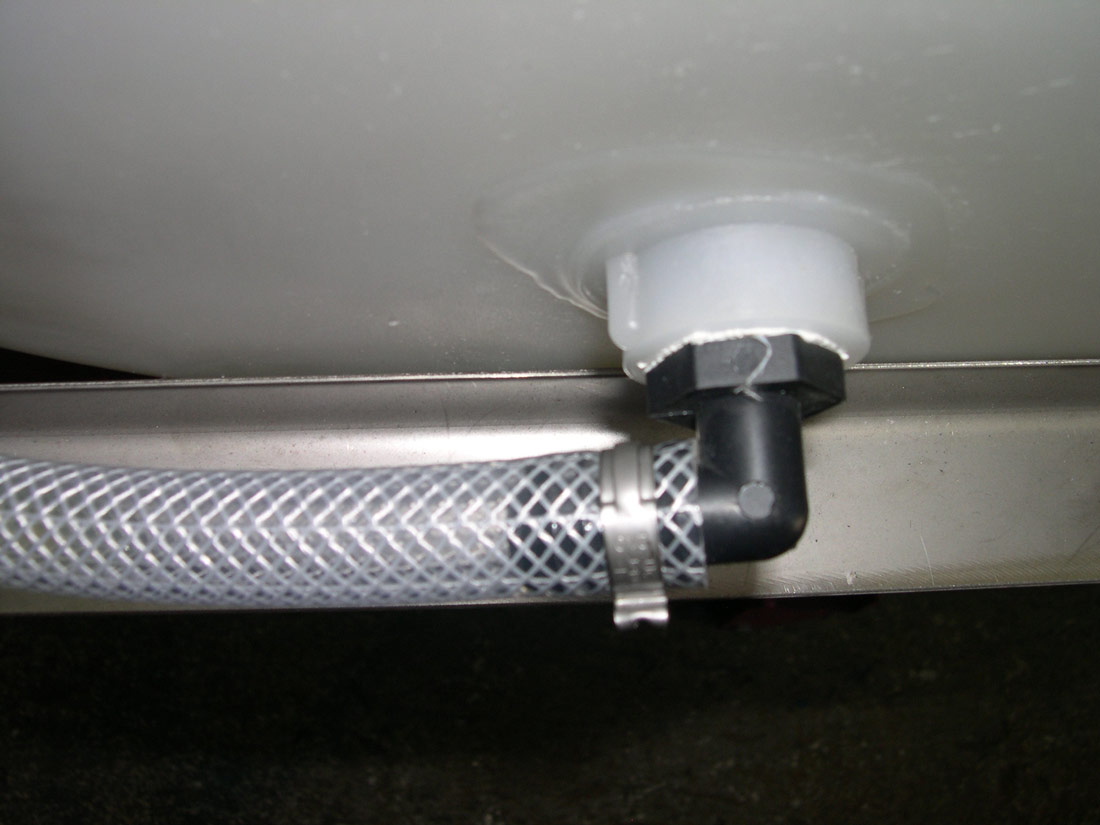Power Sprayer Tip #4 – Safety Valve to Prevent Chemical Spills
When it comes to power sprayers, most buyers pay attention to the costly components: engine, pump, tank, hose reel, spray gun, etc. This is good, but it is not enough. When it comes to power sprayers, even the little stuff matters.
Unfortunately, valves are not always used where they should be, because of the increased cost to the final product. The small incremental cost of a properly placed valve is small compared to the long term benefit of smaller chemical spills and reduced repair expenses.
This photo shows a tank penetration at the bottom of the tank, with no shut off valve, only a cheap plastic elbow fitting. This fitting is exposed to harsh chemicals, hard use and extreme weather. If the fitting were to crack (or should I say when the fitting cracks), there is no way to shut off the flow of water. The entire tank contents will spill.
Power Sprayers - Know What You Are Getting. Cheap fititngs are a big risk!
This photo shows another benefit of good valving. A properly placed valve shuts off water flow to a key component to allow servicing without having to wait for the tank to be empty. In this case, the filter can be checked even when the tank is full, by closing the gate valve. This is an example of how good valving can reduce downtime and repair expenses.
Heavy duty plumbing, plus gate valve to allow checking filter even when tank is full.
The following photo shows the plumbing under a 200 gallon spray trailer.
Cheap fittings are high risk. The question is when, not if, this will be a disaster. The manufacturer used a low cost PVC ball valve under the trailer. There are a couple of problems with the design. First, this is no place for a cheap plastic valve. A small rock kicked up off the street could crack the valve then there is no way to stop the spill. There is too much cheap plastic between the valve and the tank.
This is just more stuff to break and more places for the sprayer to leak. A crack in any fitting between the tank and the valve cannot be shut off. My suggestion here is don’t use cheap fittings in key places (or anywhere for that matter) and get the shut off valve as close to the water source as possible to reduce spill risk.
The following photo shows how a valve can be used to help prevent spills.
Spray Gun on quick disconnect with safety valve shut off to prevent leaks There is a ball valve in front of the spray gun. All spray guns have rubber o-rings which will eventually leak. The strategic placement of a shut off valve can help reduce the impact of this type of leak. In all of these examples, the cost of the valve is small when compared to the total cost of the sprayer and the cost of downtime and chemical spills that can be prevented.
Suggestions:
Inspect existing power sprayers for proper valving.
- Are valves in key places to prevent/reduce spills?
- Are valves in key places to allow access to critical components (pump, filter, etc.) even when the tank is full?
- Are valves made from high quality materials or were cheaper valves used to save money?
When purchasing new power sprayers, know what you are getting.
- Ask questions of your vendor to understand what valves are included with the sprayer. Ask about: valve quality, location and purpose
- Spray technicians use your equipment every day. Ask them where they would like to see shut off valves.
Understand what you are buying. Look at the little stuff to prepare for and anticipate problems will save you time and money down the road.
Andrew Greess - Spray Equipment Expert





